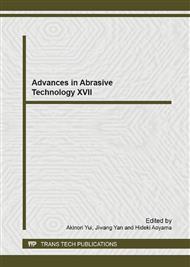p.92
p.98
p.104
p.109
p.114
p.120
p.129
p.135
p.141
Study on the Grinding Machinability of 9Mn2V under Different Heat Treatment Processes
Abstract:
The relationship between heat treatment processes and grinding performance of cold die steel 9Mn2V had been built in this paper. Serious meshy segregation of carbide, excessive amounts of retained austenite, coarse and inhomogeneous distribution of material structure were significant causes of grinding burn and grinding crack. In order to improve the abrasion-resistance and mechanical properties of workpiece material, cryogenic and tempering treatment were added. Disappear of meshy segregation of carbide, network carbide was within second grade, retained austenite content was within 4%, martensite became much more fine and homogeneous, all of these advantages could be obtained by adopting cryogenic and tempering treatment in twice. The grinding experiment results indicated that workpiece material 9Mn2V which using this process could provide superior grinding performance.
Info:
Periodical:
Pages:
114-119
Citation:
Online since:
September 2014
Authors:
Keywords:
Price:
Сopyright:
© 2014 Trans Tech Publications Ltd. All Rights Reserved
Share:
Citation:


